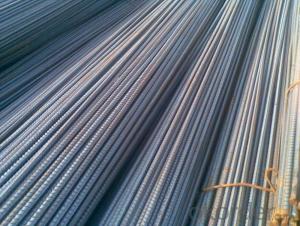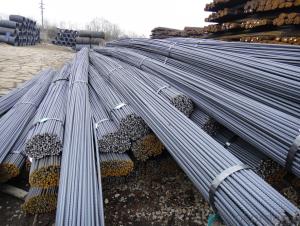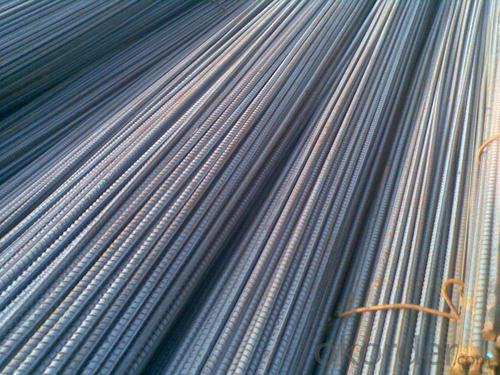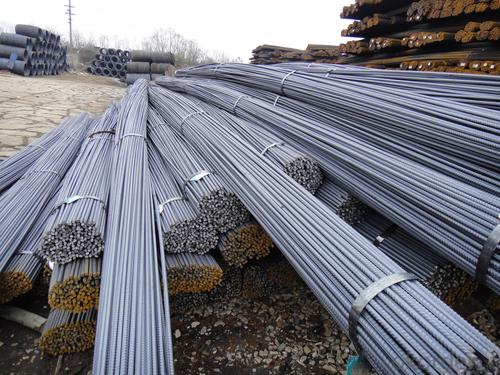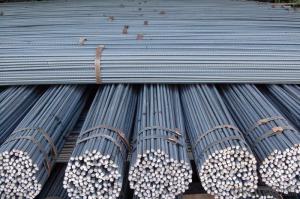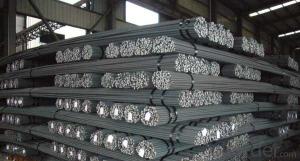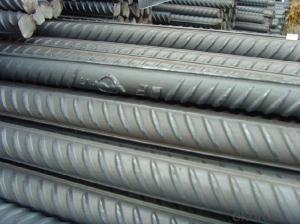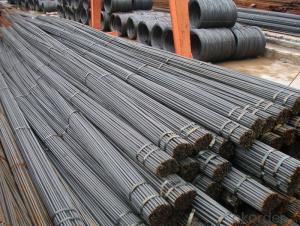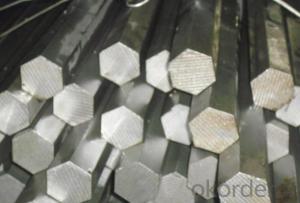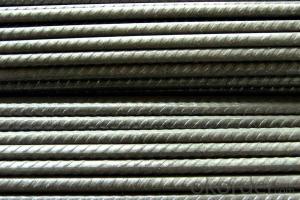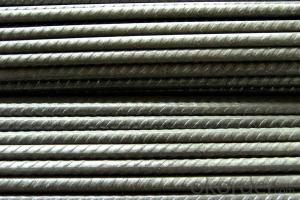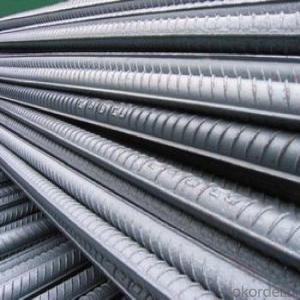Hot Rolled Carbon Steel Deformed Bar 16-25mm with High Quality
- Loading Port:
- China Main Port
- Payment Terms:
- TT or LC
- Min Order Qty:
- 25 m.t.
- Supply Capability:
- 15000 m.t./month
OKorder Service Pledge
OKorder Financial Service
You Might Also Like
Product Description:
OKorder is offering Hot Rolled Carbon Steel Deformed Bar 16-25mm with High Quality at great prices with worldwide shipping. Our supplier is a world-class manufacturer of steel, with our products utilized the world over. OKorder annually supplies products to European, North American and Asian markets. We provide quotations within 24 hours of receiving an inquiry and guarantee competitive prices.
Product Applications:
Hot Rolled Carbon Steel Deformed Bar 16-25mm with High Quality is widely used in buildings, bridges, roads and other engineering construction. Big to highways, railways, bridges, culverts, tunnels, public facilities such as flood control, dam, small to housing construction, beam, column, wall and the foundation of the plate, deformed bar is an integral structure material. With the development of world economy and the vigorous development of infrastructure construction, real estate, the demand for deformed bar will be larger and larger..
Product Advantages:
OKorder's Hot Rolled Carbon Steel Deformed Bar 16-25mm with High Quality are durable, strong.packed and suitable for construction
Main Product Features:
· Premium quality
· Prompt delivery & seaworthy packing (30 days after receiving deposit)
· Can be recycled and reused
· Mill test certification
· Professional Service
· Competitive pricing
Product Specifications:
Manufacture: Hot rolled
Grade: HRB335 HRB400 BS4449 Grade460 ASTM Grade40 Grade60
Certificates: ISO, SGS, BV, CIQ
Length:6m 8m 9m 12m
Packaging: Export packing, packed by coil
FAQ:
Q1: Why buy Materials & Equipment from OKorder.com?
A1: All products offered byOKorder.com are carefully selected from China's most reliable manufacturing enterprises. Through its ISO certifications, OKorder.com adheres to the highest standards and a commitment to supply chain safety and customer satisfaction.
Q2: How do we guarantee the quality of our products?
A2: We have established an advanced quality management system which conducts strict quality tests at every step, from raw materials to the final product. At the same time, we provide extensive follow-up service assurances as required.
Q3: How soon can we receive the product after purchase?
A3: Within three days of placing an order, we will begin production. The specific shipping date is dependent upon international and government factors, but is typically 7 to 10 workdays.
Q4: How many tons per bundle?
A4: Around 2-3tons
Q5: How to avoid the rust after deliver the goods to the loading port?
A5: We will keep the goods at the port covered with water-proof material
Q6: What is the chemical composition and physical properties of HRB400?
A6:
Grade | Technical data of the original chemical composition (%) | ||||||
C | Mn | Si | S | P | V | ||
HRB400 | ≤0.25 | ≤1.60 | ≤0.80 | ≤0.045 | ≤0.045 | 0.04-0.12 | |
Physical capability | |||||||
Yield Strength (N/cm²) | Tensile Strength (N/cm²) | Elongation (%) | |||||
≥400 | ≥570 | ≥14 | |||||
Images:
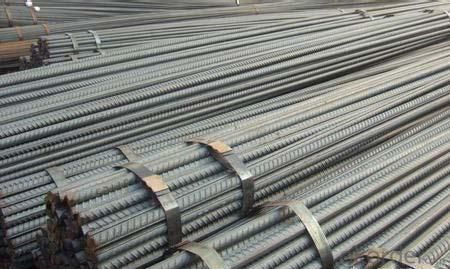

- Q: What are the factors that determine the spacing of steel rebars in a concrete structure?
- The spacing of steel rebars in a concrete structure relies on various factors that guarantee the concrete's structural integrity and strength. These factors encompass: 1. Structural Design: The spacing of rebars is influenced by the structural design requisites and specifications of the concrete structure. Engineers take into account the loads, stresses, and forces that the structure will endure and compute the necessary reinforcement spacing accordingly. 2. Concrete Strength: The concrete's strength used in the structure is a pivotal determinant in establishing rebar spacing. Higher-strength concrete may necessitate closer spacing of rebars to provide ample reinforcement and prevent cracking or failure under load. 3. Rebar Diameter: The diameter of the steel rebars also contributes to determining the spacing. Thicker or larger diameter rebars may require wider spacing, while thinner rebars typically necessitate closer spacing to deliver the desired reinforcement. 4. Bar Bending and Placing: The ease of bending and placing the rebars during construction is another crucial factor. Often, practical considerations dictate the spacing, such as guaranteeing proper access for workers and equipment and facilitating the concrete pouring process. 5. Environmental Factors: Environmental conditions, including exposure to corrosive substances or extreme weather conditions, can impact rebar spacing. Closer spacing may be necessary in corrosive environments to provide additional protection against rust and deterioration. 6. Building Codes and Regulations: Local authorities or relevant organizations establish building codes and regulations that set the minimum requirements for rebar spacing in concrete structures. These codes ensure compliance with safety standards and offer guidelines for construction practices. In conclusion, the spacing of steel rebars in a concrete structure is a crucial aspect in ensuring its strength, durability, and resilience. It relies on a combination of factors, including structural design, concrete strength, rebar diameter, construction practicalities, environmental considerations, and adherence to building codes and regulations.
- Q: Can steel rebars be used in structures with limited maintenance access?
- Structures with limited maintenance access can utilize steel rebars, which are commonly chosen for construction projects due to their exceptional strength and durability. These rebars can endure heavy loads and provide reinforcement to concrete structures. In structures with restricted maintenance access, steel rebars offer numerous benefits. Firstly, they boast a lengthy lifespan and are corrosion-resistant, minimizing the need for frequent maintenance. Unlike wood or aluminum, steel rebars do not decay or rot over time, rendering them suitable for structures that are challenging to reach for regular maintenance. Moreover, steel rebars can be easily examined using non-destructive testing methods like ultrasound or magnetic particle inspection. These techniques can identify any potential flaws or damage in the rebars without invasive measures, thereby ensuring the structural soundness of the building. Furthermore, steel rebars can be designed and installed in a manner that reduces the necessity for future maintenance. For instance, employing epoxy-coated rebars can provide an additional layer of protection against corrosion, prolonging the structure's lifespan and reducing maintenance requirements. However, it is crucial to acknowledge that while steel rebars are highly durable, they are not entirely maintenance-free. Over time, the protective coatings on the rebars may deteriorate, and if left unaddressed, corrosion can occur. Therefore, periodic inspections and maintenance activities must still be conducted, even in structures with limited access. In conclusion, due to their durability, corrosion resistance, and non-invasive inspection capabilities, steel rebars can be employed in structures with limited maintenance access. Nevertheless, regular inspections and maintenance are still necessary to ensure the long-term performance of the rebars and the overall structural integrity of the building.
- Q: How are steel rebars stored and handled on construction sites?
- Steel rebars are typically stored in designated areas on construction sites to ensure easy access and organization. They are often stacked horizontally and secured with supports to prevent them from rolling or falling. When handling rebars, workers wear appropriate protective gear and use equipment such as cranes or forklifts to lift and move them safely. Additionally, rebars are carefully inspected for any defects or damages before being used in construction projects.
- Q: What is the role of steel rebars in preventing concrete cracking?
- Steel rebars play a crucial role in preventing concrete cracking by providing reinforcement and enhancing the overall strength and durability of concrete structures. When concrete undergoes tensile stress, it tends to crack due to its low tensile strength. However, steel rebars, which are typically embedded within the concrete, act as a reinforcement by absorbing and distributing these tensile forces throughout the structure. The presence of steel rebars in concrete helps to counteract the natural tendency of concrete to crack under tension. When a load is applied to the concrete, the rebars bear a significant portion of the tensile stress, preventing it from being solely concentrated on the concrete matrix. This distribution of forces helps to minimize the formation and propagation of cracks, ensuring the structural integrity of the concrete. Moreover, steel rebars also contribute to the overall strength and durability of concrete structures. The combination of steel's high tensile strength and concrete's compressive strength results in reinforced concrete, which exhibits superior resistance to various external forces such as bending, shear, and seismic loads. This added strength makes the concrete less susceptible to cracking and enhances its ability to withstand heavy loads and environmental factors over time. In summary, steel rebars play a crucial role in preventing concrete cracking by providing reinforcement, absorbing and distributing tensile forces, and enhancing the overall strength and durability of concrete structures. Their presence significantly improves the structural integrity and longevity of concrete, making it a reliable and widely used construction material.
- Q: Can steel rebars be used in structures with limited construction materials?
- Steel rebars have the potential to be utilized in structures where there is a scarcity of construction materials. They are extensively employed in construction for reinforcing concrete structures, like buildings, bridges, and highways. Their role is to enhance the strength and stability of the structure, enabling it to endure heavy loads and prevent structural failure. In regions where construction materials may be limited, steel rebars can be an invaluable asset. Their durability and versatility make them suitable for various applications, rendering them a flexible choice for construction projects. Furthermore, their ease of transportation and installation make them appropriate for implementation in remote or inaccessible areas. Nonetheless, it is crucial to take into account the specific requirements and regulations of the construction project when employing steel rebars. Adequate knowledge and expertise are imperative to ensure accurate installation and adherence to safety standards. Additionally, if there are any specific limitations or restrictions on the usage of particular construction materials, it is crucial to seek advice from local authorities or professionals to determine the most suitable course of action.
- Q: How do steel rebars improve the structural integrity of a building?
- Steel rebars improve the structural integrity of a building by reinforcing concrete structures, providing additional strength and stability. The rebars act as a skeleton within the concrete, distributing and transferring loads more effectively, preventing cracks and reducing the risk of collapse.
- Q: How are steel rebars used in foundation construction?
- Steel rebars are used in foundation construction to provide reinforcement and strength to the concrete. They are placed within the concrete to withstand the tension and stress that the foundation may experience, ensuring its stability and durability over time.
- Q: What is the effect of exposure to chemicals on the durability of steel rebars?
- Exposure to chemicals can have a detrimental effect on the durability of steel rebars. Certain chemicals, such as acids, alkalis, and salts, can corrode the surface of the rebars, leading to the formation of rust and weakening the steel structure. This corrosion process can significantly reduce the lifespan and structural integrity of the rebars, compromising the overall durability of the construction. Therefore, proper protective measures and regular maintenance are crucial to mitigate the negative effects of chemical exposure on steel rebars.
- Q: What is the lifespan of steel rebars?
- The lifespan of steel rebars can vary depending on various factors such as the quality of the steel, environmental conditions, and maintenance practices. Generally, steel rebars have a long lifespan and are designed to provide structural reinforcement for many years. With proper installation and maintenance, steel rebars can last for several decades or even more than a century. However, factors like exposure to corrosive environments or lack of maintenance can significantly reduce their lifespan. Regular inspections, protective coatings, and proper drainage systems can help extend the lifespan of steel rebars and ensure their long-term durability.
- Q: How are steel rebars coated with epoxy?
- Epoxy coating, also known as epoxy rebar coating, is utilized to coat steel rebars for the purpose of protection against corrosion and other environmental factors. To initiate the process of coating steel rebars with epoxy, the first step involves preparing the surface. This essential stage entails the thorough cleaning of the rebars to eliminate any dirt, oil, or rust present. The significance of surface preparation lies in ensuring proper adhesion of the epoxy to the steel surface. Once the surface is adequately prepared, the application of the epoxy coating commences. There are various methods available for this application, including spraying, brushing, or dipping the rebars into an epoxy solution. The choice of method depends on factors such as the rebars' size and shape, as well as the desired thickness of the epoxy coating. Subsequent to the application of the epoxy, the rebars are allowed to cure. Curing is the process during which the epoxy hardens and attains its maximum strength. The duration of this process may vary depending on the specific epoxy product utilized, but it generally takes several hours or even days for the epoxy to fully cure. Upon achieving complete curing, the coated rebars are prepared for use. The epoxy coating acts as a protective barrier, effectively preventing the steel rebars from rusting and deteriorating over time. Additionally, it enhances the rebars' resistance to chemicals, moisture, and other corrosive substances. To summarize, epoxy coating proves to be an efficient method for safeguarding steel rebars against corrosion and extending their lifespan. It finds extensive application in construction projects wherein rebars are exposed to harsh environmental conditions, such as bridges, buildings, and infrastructure projects.
Send your message to us
Hot Rolled Carbon Steel Deformed Bar 16-25mm with High Quality
- Loading Port:
- China Main Port
- Payment Terms:
- TT or LC
- Min Order Qty:
- 25 m.t.
- Supply Capability:
- 15000 m.t./month
OKorder Service Pledge
OKorder Financial Service
Similar products
Hot products
Hot Searches
Related keywords
